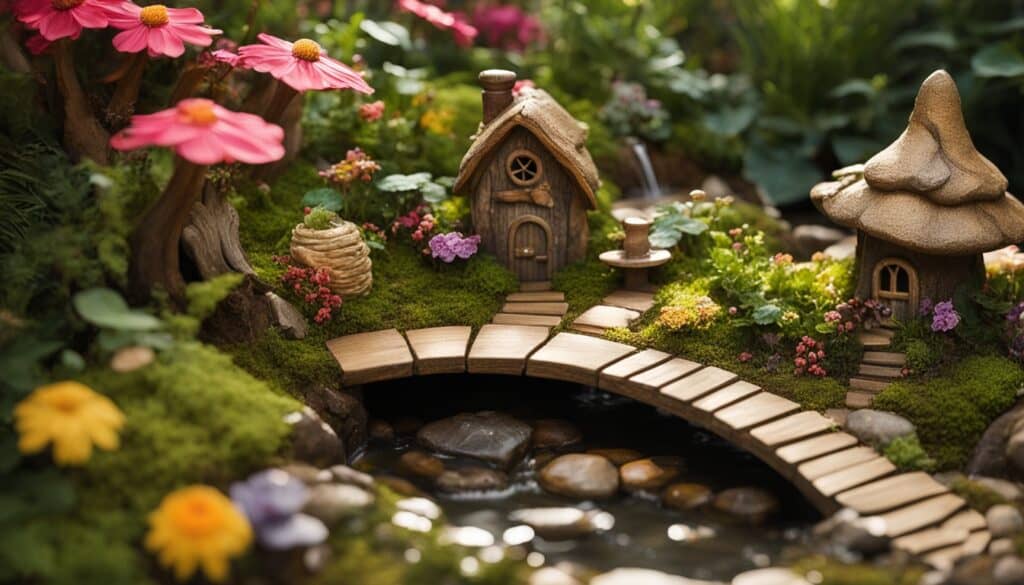In April 2015, I moved into my cozy studio. I didn’t know a simple project would mean so much. For just $35.00 at Hobby Lobby, I made my first fairy garden. It had wooden birdhouses, small terra cotta pots, and bright silk flowers. This tiny garden was my escape, bringing fairytales to life on my windowsill.
Fairy gardens capture our hearts with their magic. They come from old European tales. People used them to explain nature, weather, and health. Now, they’re for fun and teaching, for both kids and grown-ups. They mix gardening with stories.
You can make fairy gardens in many ways. From teacups to big terrariums, it’s all about your creativity. They show the seasons and can live inside or outside. Making them is fun and good for you. With over 25 ideas to try, you’ll never run out of magic.
Key Takeaways
- Fairy gardens blend creativity and calm, connecting us with nature and folklore.
- These projects appeal to both adults and kids, offering therapeutic benefits and fun.
- DIY fairy gardens can be crafted in various styles and sizes, fitting into any space.
- Imagination and patience are key to creating enchanting fairy garden designs.
- Fairy gardens are versatile, perfect for both indoor and outdoor seasonal displays.
The Magic of Fairy Gardens
Fairy gardens mix fantasy and gardening, turning simple spaces into magical mini-worlds. The magic comes from crafting a detailed landscape. It appears as though tiny fairies made it.
Fairy garden magic captures wonder through the idea of scale. Picking the right-sized decorations is essential. You aim to create an inviting scene, full of mystery and spots to discover.
Starting is easy. Just choose a container, like a dish that’s two inches deep. Add terrarium ferns or plants for a natural fairy touch. Hunting for mini furniture at thrift shops adds an eco-friendly twist to your garden.
Fairy tales have been told for centuries, from the British Isles to Scandinavia. Yet, fairy garden magic appeals to modern folks too. Whether it’s a tiny pot or a large garden bed, there are no strict rules. This freedom lets everyone craft unique and joyous gardens.
Spring or early summer is a great time to start your fairy garden. The warm weather and flowers enhance its charm. Revamping your garden annually keeps the magic alive. As shown by Maisy Root’s five-year-old garden, it thrives with a bit of care.
Building a fairy garden is more than a creative task. It’s a way to connect with nature and others. It teaches kids skills, as Martha Duerr knows, or gives you personal joy. The rewards are endless.
Creating Seasonal Fairy Gardens
Seasonal fairy gardens are magical projects for any season. You can make a frosty winter scene or a brightly-colored summer garden. Every season offers unique inspiration. For spring, add pastel colors and blooming flowers. Fall gardens look great with mini pumpkins and cozy scenes.
Choosing the right container is key for your garden. It should match the season’s feel. Adding things like mini gazebos or bridges makes it come alive. And don’t forget about whimsical characters! Fairies, dragons, or animals add charm to your garden.
Plants are essential in fairy gardens. They change the look and feel depending on the season. Use Creeping Thyme or Irish Moss for ground cover. Try Golden Stonecrop for texture. Baby’s Tears and Corsican Mint bring lush green looks. Adding seasonal accessories, like pebbles or sand, makes it personal.
For autumn, use mini pumpkins and ghostly figures to celebrate Halloween. You can find tiny tombstones and witchy accessories too. Add Spanish moss for a spooky touch. Winter gardens shine with mini snowmen and icicles. You have endless options.
Incorporate architectural elements to sprinkle more magic. Baker’s Village Garden Center has stuff like gazebos and bridges. Changing accessories and plants with the seasons keeps your garden fresh. It will be inspiring all year.
No matter the season, aim to capture its unique charm. Creating these mini worlds might become your favorite hobby. And the journey is as special as the gardens themselves.
Design Tips and Inspiration
Diving into seasonal fairy garden designs is full of joy. First off, pick a theme you love, like a beach or forest retreat. This theme will help guide your fairy garden journey.
Consider adding gnomes, mini furniture, and tiny swings. These can turn a simple spot into a whimsical haven. Right now, container-based fairy gardens are popular. They’re easy and great for small areas, with costs from $20 to $50.
Creating a fairy garden means buying everything from containers to tiny plants. Some gardens may cost over $100 but are worth it. For a DIY project, try turning an old wheelbarrow into a garden. It’s fun and can hold decorative or edible plants.
You can pick from many styles like Tudor or French country. Each style brings a unique feel. Getting kids involved adds a special touch they’ll love.
As seasons change, so should your fairy garden. Add colorful flowers in spring and summer. For fall and winter, try succulents and sedum. A cluster of Dianthus by a tiny fence makes a lovely focal point.
Fairy garden decor is fun. Use glow-in-the-dark mushrooms or mirrors for special effects. Look for vintage items at antique stores to add charm.
Don’t forget the power of stories. Your fairy garden tells a tale, making it more than just decor. Let your creativity fly as you build this magical world. Enjoy every step of making your enchanted retreat!
Maintaining Your Fairy Garden Throughout the Year
Maintaining a fairy garden all year is truly magical. It feels like caring for a tiny, enchanted world. Indeed, keeping up with seasonal fairy garden maintenance is quite a detailed task.
Let’s dive into the basics of fairy garden care. No matter its age, your garden requires season-specific attention. In the scorching summer months, it’s crucial to keep the moss wet. Remember, dry moss doesn’t look or feel good. And, oh, the hot summer of 2012 taught us the importance of extra hydration for our mini gardens.
Winter brings its own magic with snow acting as insulation for plants. It’s fascinating how snowflakes serve as tiny, cozy blankets for them. Yet, in freezing temperatures, your plants may need even more protection. Think of it like bundling your garden in a warm coat.
Managing your miniature plants is essential for seasonal fairy garden care. Overgrown plants like Fairy Vine and Baby Tears need regular trimming. Doing so prevents your garden from becoming an untamed wilderness.
Don’t overlook the conifers, either. Clearing out dead parts is important for their health. It keeps the tiny trees vibrant and beautiful.
Here’s a final tip: update your garden’s decorations with the seasons. Changing up the scenery helps keep things fresh. Remember, simplicity brings out the garden’s charm best. An uncluttered space allows for endless creativity and enchantment.
So, pick up your miniature toolkit and enjoy maintaining a fairy garden for different seasons. With love and a little magic, your garden will always be a wonder, captivating everyone’s hearts through the seasons.
Conclusion
Reflecting on my journey in fairy gardening has shown me its magic. It’s grounding and inspiring. Choosing plants like impatiens and solar houses adds endless creativity.
This hobby connects us with others who love fairy gardens. Sharing experiences has sparked new ideas. From miniature houses to battery-operated candles, every detail makes it special.
The joy of fairy gardening is in the making. It lets us express ourselves and escape to a magical world. Every season changes our tiny landscapes, turning them into stories. When you see your fairy garden, remember: it’s a doorway to where creativity and nature meet.



